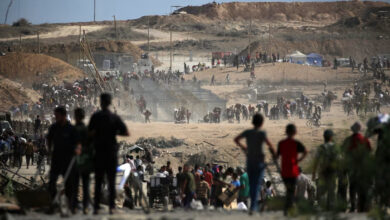
A Marine rapid response force is expected to leave the eastern Mediterranean Sea in the coming weeks and return to the United States, according to two defense officials, in a significant reduction of US forces in the region.
The USS Bataan amphibious ready group and the 26th Marine Expeditionary Unit (MEU) are expected to begin sailing toward the US in March, one official said, though an exact timeline for the departure is unclear. The Pentagon could still decide to keep the group in the region if the situation rapidly deteriorates.
The Marine rapid response force first deployed in July and was sent to the region in October. It had previously been extended to remain in the eastern Mediterranean Sea, as CNN reported. Capable of carrying out amphibious operations and certain special operations, the Marines are also trained to assist in evacuation operations, one of the reasons they were sent at the beginning of the Gaza war. But as the war nears its fifth month, the need for an evacuation of American citizens has not materialized.
The Pentagon declined to comment.
The US has maintained an aircraft carrier or amphibious assault ship in the eastern Mediterranean Sea since shortly after the October 7 attacks in Israel. The warships were intended to deter Iranian proxies in the region, such as Hezbollah in Lebanon, from escalating the already volatile situation and risking a wider regional conflict.
At least for now, Iranian proxies in the region have halted their attacks on US forces in Iraq and Syria. After a steady stream of attacks following the beginning of the Gaza war – US forces were attacked at least 170 times since the war began – there has not been an attack on US forces in more than three weeks. The abrupt cessation of attacks comes after a one-way drone attack killed three US service members and wounded approximately 70 others in Jordan at the end of January.
“We certainly welcome that there hasn’t been any attacks,” said Pentagon deputy press secretary Sabrina Singh at a briefing Thursday. “I think we sent a very strong message with our strikes, and we will continue to do so if we need to, and we’ll do so at a time and place of our choosing.”
The anticipated return of the USS Bataan will mean the US does not have a warship capable of operating fighter jets in the eastern Mediterranean Sea for the first time since October. The Bataan group includes 4,000 sailors and Marines — roughly 2,000 of whom are part of the 26th MEU — and carries more than 24 fixed-wing and rotary-wing aircraft.
The US still has a guided missile destroyer in the eastern Mediterranean Sea and other warships nearby that could be sent to the region if needed. The USS Dwight D. Eisenhower carrier strike group is currently operating in the Red Sea. Navy F/A-18 fighters jets from the carrier and destroyers from the group have carried out multiple strikes against Houthi targets in Yemen, as well as repeatedly intercepting launches from the Houthis against commercial and naval ships. On several occasions, the US has also destroyed maritime drones.
Shortly after October 7, Defense Secretary Lloyd Austin ordered the USS Gerald R. Ford carrier strike group to the eastern Mediterranean. Days later, the USS Dwight D. Eisenhower carrier strike group deployed from the US and headed for the region. The USS Bataan amphibious ready group, which was already in the Gulf of Oman as part of an effort to deter Iranian aggression, was also sent to the waters near Israel.
That put three major groups of warships, including thousands of sailors and a Marine ready response force, in the Middle East at the same time, a major concentration of US forces in response to the war in Gaza.
But in January, as the war reached the three-month mark and showed no signs of a lasting ceasefire, the US began to pull some of its forces from the region. The Ford carrier strike group, which had been extended several times, left the eastern Mediterranean Sea in early-January, replaced by the Bataan amphibious ready group and the Marine rapid response force.
The US was also actively working to mediate a reduction in the fighting along the Lebanese border between Israel and Hezbollah.




